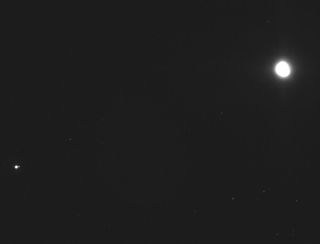See the Earth, Moon and Asteroid Bennu in a Single Photo

Here's something you don't see every day: Earth, the moon and a potentially dangerous asteroid, all in the same frame.
NASA's OSIRIS-REx probe captured the photo on Dec. 19, when it was about 71 million miles (114 million kilometers) from its home planet but much closer to the space rock Bennu.
"The spacecraft's range to Bennu is only about 27 miles (43 kilometers), so the asteroid appears highly overexposed in the upper right," OSIRIS-REx team members wrote in an image description. "The head of the constellation Hydra is also visible in the lower right portion of the image."
The $800 million OSIRIS-REx mission arrived at Bennu on Dec. 3 and slipped into orbit around the 1,650-foot-wide (500 meters) space rock four weeks later, setting several records in the process. No probe had ever circled such a small celestial body before or orbited a small object so closely. (OSIRIS-REx currently circles about 1 mile, or 1.6 km, above Bennu's boulder-strewn surface.) [OSIRIS-REx: NASA's Asteroid Sample-Return Mission in Pictures]
The spacecraft will study Bennu from this perch for a while, then dip down to the asteroid's surface and grab a sample in mid-2020. If all goes according to plan, this Bennu material will come down to Earth in a return capsule in September 2023.
Analysis of the returned sample should reveal a great deal about the early days of the solar system, as well as the role that carbon-rich asteroids such as Bennu may have played in helping life get started on our planet, NASA officials have said.
The mission will make other contributions as well. OSIRIS-REx's data should help scientists better understand the forces that shape asteroids' trajectories, possibly improving impact predictions, mission team members have said. The spacecraft's observations should also help scientists gauge the resource potential of Bennu-like asteroids.
Get the Space.com Newsletter
Breaking space news, the latest updates on rocket launches, skywatching events and more!
As noted above, Bennu is a potentially hazardous asteroid. But don't panic — this designation applies to all decently large space rocks that can get within 0.05 astronomical units (AU) of Earth at some point in their orbits. (One AU is the Earth-sun distance — about 93 million miles, or 150 million km.)
And Bennu isn't a particularly scary member of that class: There's just a 1-in-2,700 chance that the asteroid will hit Earth between the years 2175 and 2199, according to NASA researchers.
OSIRIS-REx is short for "Origins, Spectral Interpretation, Resource Identification, Security-Regolith Explorer."
Mike Wall's book about the search for alien life, "Out There" (Grand Central Publishing, 2018; illustrated by Karl Tate), is out now. Follow him on Twitter @michaeldwall. Follow us @Spacedotcom or Facebook. Originally published on Space.com.
Join our Space Forums to keep talking space on the latest missions, night sky and more! And if you have a news tip, correction or comment, let us know at: community@space.com.

Michael Wall is a Senior Space Writer with Space.com and joined the team in 2010. He primarily covers exoplanets, spaceflight and military space, but has been known to dabble in the space art beat. His book about the search for alien life, "Out There," was published on Nov. 13, 2018. Before becoming a science writer, Michael worked as a herpetologist and wildlife biologist. He has a Ph.D. in evolutionary biology from the University of Sydney, Australia, a bachelor's degree from the University of Arizona, and a graduate certificate in science writing from the University of California, Santa Cruz. To find out what his latest project is, you can follow Michael on Twitter.
